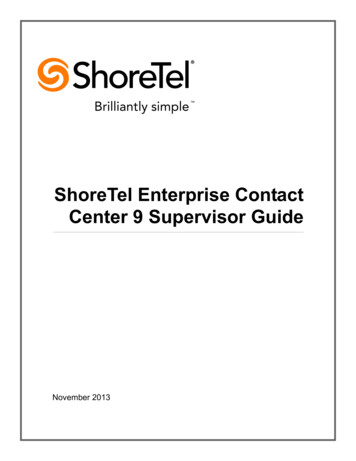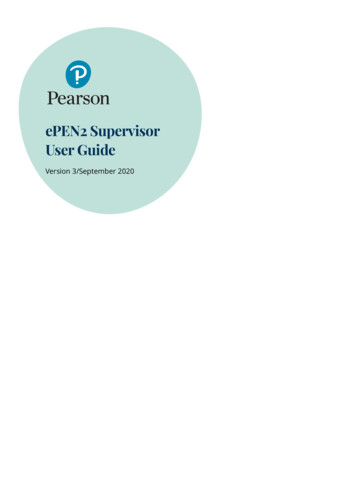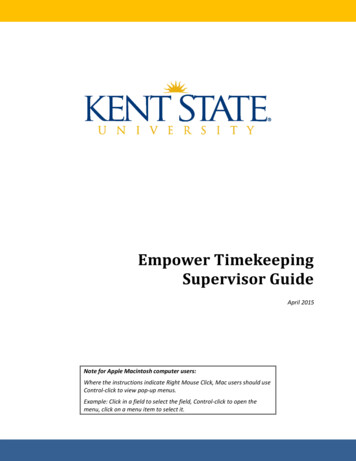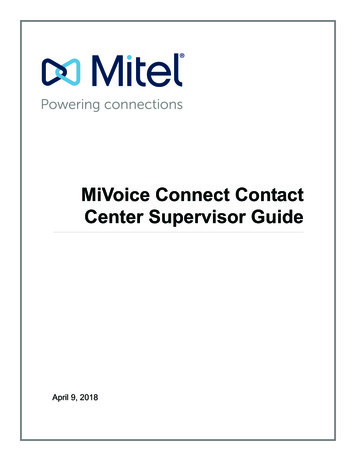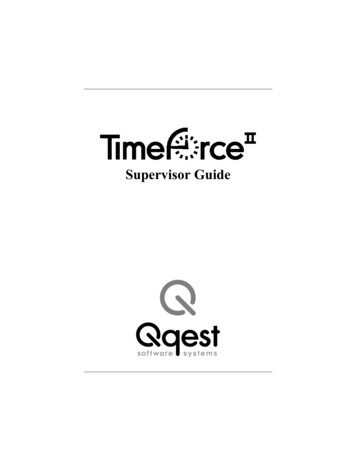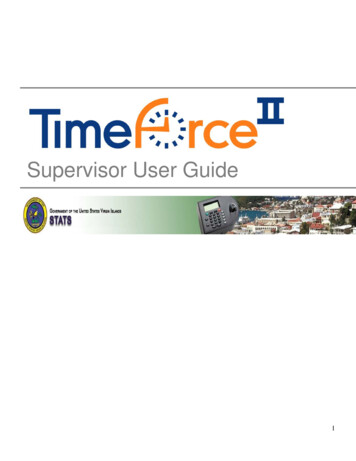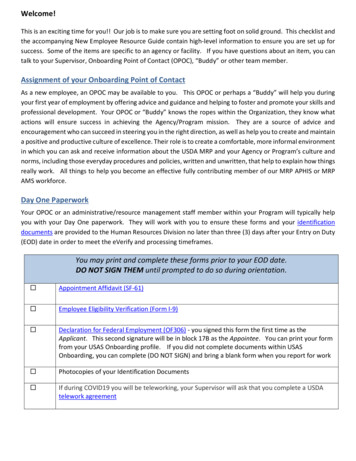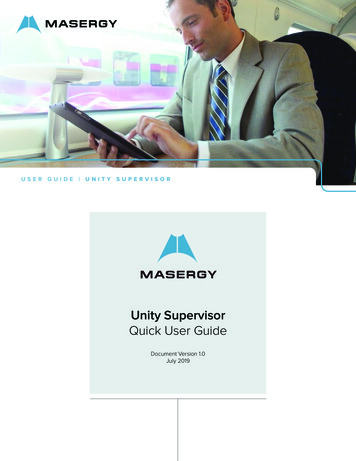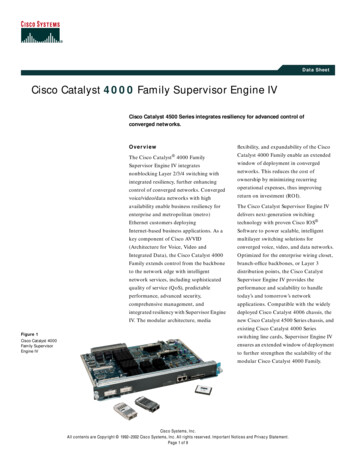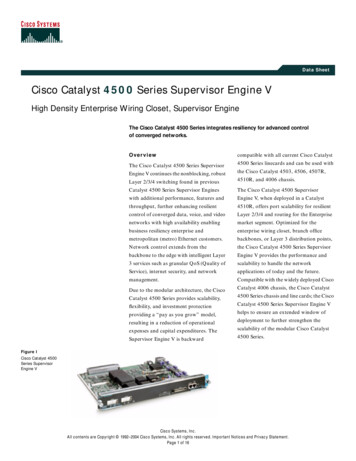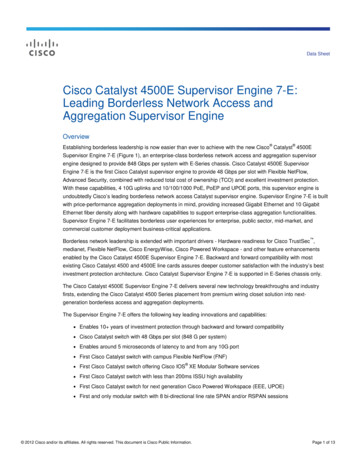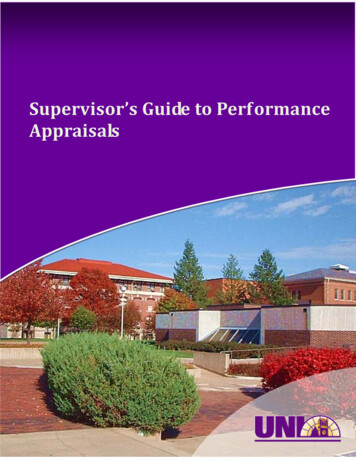
Transcription
Supervisor’s Guide to PerformanceAppraisals
Table of ContentsIntroduction .3Benefits of Productive Performance Meetings .3Performance Goals Help Employees .3Performance Goals Help Supervisors .4Preparing the Employee and Scheduling the Performance Meeting .4Completing the Annual Performance Summary Form .4Conducting the Performance Meeting .7Helping Employees Set Career Goals.9Guidelines for Handling a Meeting with a Poor Performer.10Discussing Employee Attitude Problems.11Addressing Emotional Situations .11Crying .11Shouting .12Walking Away .12Becoming Silent.12Quick to Agree .12Preparing for Next Year’s Performance Appraisal.12Documenting Job Performance .13Coaching Employee Performance .14Planning and Preparation .14Conducting a Coaching Session .15Action-planning and Follow-up.16How Human Resource Services Can Assist .17Page 2
Supervisor’s Guide to Performance AppraisalsIntroductionThe following guidelines are designed to assist you in conducting performance appraisals ofemployees who report to you. It is very important to assess job-related performance and notpersonality unless it relates directly to the employee’s performance. Please keep in mind thatyou are a role model for those who report to you. There is no substitute for courtesy, sensitivity,and a common sense approach to the performance appraisal process.This guide has been developed in conjunction with the revision of the annual appraisals formsused for Merit (AFSCME) employee by the 2000 Merit Evaluation Task Force, including taskforce members and employees from AFSCME, the Department of Residence, Library, PhysicalPlant, Print Services, and Human Resource Services. In certain instances, reference is made tothe actual evaluation forms used for Merit employees, including the Annual PerformanceSummary and the Discussion Guide for Annual Performance Summary.This guide may also be used as a reference tool by supervisors who conduct performanceappraisals of other employee classifications, such as Professional & Scientific. Where referenceis made to the specific Merit evaluation forms, please substitute the forms that you have beenprovided for use.Benefits of Productive Performance MeetingsA productive performance meeting serves as a collaborative planning session during which boththe supervisor and the employee can take an in-depth look at past and current performancesand can together set new goals and objectives for the coming year.The performance meeting helps the supervisor and employee establish a clearer understandingof the employee’s job duties, responsibilities, and priorities. It also provides an opportunity forthe supervisor to coach the employee on how to become more proficient and productive.Establishing performance goals provides direction and helps the employee and supervisor in thefollowing ways:Performance Goals Help Employees: Find out how they are doing. Know what is expected of them. Take responsibility for their performance. Learn their performance strengths and weaknesses. See where their goals support organizational goals. Direct efforts where they can do the most for their own careers and for group andorganizational success.Page 3
Feel that they are taken seriously as individuals and that the supervisor is trulyconcerned about their needs and goals.Performance Goals Help Supervisors: Develop an objective means for evaluation employees. Tie individual tasks, goals, and direction to group and organizational goals. Work with employees on career development plans and paths. Identify where individuals need coaching and training. Provide recognition and motivation to employees. Document an employee’s progress towards reaching goals.For further information regarding the performance review process, you may borrow trainingvideos from Human Resource Services by contacting the receptionist at 319-273-2422.Preparing the Employee and Scheduling the Performance MeetingAdvise the employee of the performance meeting at least one week in advance. Ask theemployee to complete the optional Discussion Guide for Annual Performance Summary to bringto the meeting. The purpose of the Discussion Guide for Annual Performance Summary is toencourage communication and to provide discussion points between the employee andsupervisor during the performance meeting. The Discussion Guide for Annual PerformanceSummary can also be obtained from UNI’s Forms Repository located athttp://access.uni.edu/forms/index.shtml.Also, let the employee know that you intend to discuss his/her personal career objectives at themeeting. If you have done this in the past, you may want to provide the employee with a writtenlist of goals that you both set during the last performance meeting. Ask the employee to thinkabout what progress has been made toward those goals and what goals he/she would adjustthe priorities that have been set.The date and time that you schedule the meeting for should be mutually convenient to you andthe employee. Set aside at least one hour with no ringing telephones or interruptions and find aprivate room for the meeting. When scheduling consecutive performance meetings, ensurethere is enough time between them so you do not rush the appraisal process.Completing the Annual Performance Summary FormThe better prepared you are for the performance appraisal meeting, the more productive yourdiscussion will be. It all starts with your completion of the Annual Performance Summary formthe more time and effort you put into completing it, the better prepared you will be for thePage 4
Supervisor’s Guide to Performance Appraisalsappraisal meeting. Before sitting down to complete the Annual Performance Summary for anemployee, gather the following information and documents for your review and reference: Employee’s job description;Date employee began present position;Length of time the employee has reported to you; Record of employee’s attendance during past year;Your notes or journal regarding the employee’s performance during the past year;Current projects the employee is working on and employee’s progress; Examples of work problems you want to discuss; Examples of employee’s work over the past year and recent work;How employee relates to co-workers, internal and external customers, and others;Level of employee’s technical skills; Employee’s educational background and experience;List of job and career objectives drawn up during past performance review; List of training and development courses attended by employee during past year;List of available training courses appropriate for employee for upcoming year.When completing the evaluation form, consider whether the employee met his/her goals for theperiod. If not, were there any outside circumstances (new orders, staff cuts, equipmentproblems) that limited the employee’s ability to meet goals? Did you provide the employee withfeedback on progress toward goals during the year? Do you have records of specific examplesof successes, improvements, or weaknesses? Do your examples include feedback form internaland external customers, other supervisors, etc?When rating an employee on different factors, base the ratings on how well the employeeperformed his/her job. Be careful of dramatic declines such as “exceeds expectations” to “needsimprovement.” The supervisor must address all “needs improvement” ratings as well as otherissue, in the “supportive details or comments” section of the form. All comments made shouldbe meaningful and consistent with performance rankings. It is important to be aware of, and toguard against, the following common tendencies:Page 5
Rating TendencyHalo EffectOpposite of HaloEffectCentral TendencyRecent BehaviorSpillover EffectStatus EffectSame as MePersonalBias/PrejudiceExplanationA tendency to rate high on one quality which may influence a higher thandeserved rating on another quality, such as rating someone high because youpersonally like him/her.A rating of unsatisfactory on one quality may influence a lower than deservedrating elsewhere, such as rating someone low because you do not like his/herpersonal style.Rating performance as average or around the midpoint. This is the mostcommon and serious of the rater tendencies.Basing the rating on recent performance on a project rather than overallperformance throughout the past year.Allowing past performance appraisals to unjustly influence current ratings.Over-rating employees in jobs held in high esteem and under-ratingemployees in lower level jobs or those held in low esteem.Rating an employee higher than deserved because of dissimilar personalitycharacteristics from the rater.Rating affected by national origin, age, sex, race, religion, physicalcharacteristics, manner of speech, etc.Keep your appraisal or comments regarding the employee’s performance specific, related to theemployee’s goals, fair and objective, and based on what occurred during the entire reviewperiod. The appraisal should be concerned solely with job behaviors and efforts, not personality.Avoid comparing the employee’s performance to that of other employees.Considering the following criteria when preparing employee performance documentation imelinessExplanationWho did what, when, and what was the result?What did the employee actually do?Are all the relevant points covered/Does documentation cover the same performance areas with the same level ofdetail for all employees in the same job/Does employee get credit for taking responsibility, putting in extra time,volunteering, following instructions, etc?Does it relate to the particular employee’s goals?Can progress in meeting performance goals be measured or given numericalsupport?Can you show that the employee did or did not complete the task successfully?Does the documentation reflect incidents in the current review period?Once the evaluation form is completed, it is recommended that you review it with yoursupervisor before meeting with the employee to ensure the both levels of management are inagreement regarding the employee’s performance.Page 6
Supervisor’s Guide to Performance AppraisalsConducting the Performance Meeting1. Put the employee at ease by creating a sincere and open atmosphere for jointdiscussion.2. Establish the purpose of the discussion. Advise the employee what you would like toaccomplish during the meeting.3. Review the employee’s overall job requirements and responsibilities. Going over the jobdescription with the employee allows you to discuss the work that the employee does ona daily basis. If the two of you disagree on the relative importance of specific jobaspects, it will come out now, and it will also give you the opportunity to discuss anyproblems the employee is having performing the various job responsibilities.4. Review the performance objectives and goals established during the last performancemeeting with the employee.a. Discuss objectives/goals that have been reached. How has that improved theemployee’s skills and performance?b. Discuss objectives/goals that need further work. What obstacles have preventedthe employee form reaching any objectives? Decide if time frames set forreaching the objectives need to be adjusted.5. Provide recognition for desirable behavior, especially since the last review. Let employeeknow how much you value and appreciate their work.6. Ask for the employee’s views on problems, suggestions for changes, improvements, etc.a. Do not interrupt the employee’s commentary. If the employee is upset, lethim/her blow off steam. Be a good listener.b. Thank the employee for his/her input. If the meeting has included discussion ofmajor concerns about the quality of the employee’s performance, expressconfidence that the two of you can successfully work through the difficultiestogether.7. Outline one or two areas of performance where improvements are needed and ask forthe employee’s suggestions.a. Do not unload-keep the meeting as upbeat and positive as possible, but behonest and accurate.b. Avoid using subjective, vague, or overly broad descriptions, such as “poorattitude” or “no initiative.” Give specific, objective comments and/or examples.Page 7
Examples of SubjectiveCommentsLacks customer orientation.Chronically absent.Does not care about the quality.Lacks interest in the work.Examples of ObjectiveCommentsDoes not greet customers quickly.Absent six days last month.Has an error rate of 10%.Missed the due date forassignment.c. Be consistent. If an issue (weakness of performance) was mentioned on theprevious performance appraisal, it should be mentioned again if it is still an issue.An omission may lead to the assumption that the problem has been resolved.Conversely, if there has been improvement since the last appraisal, acknowledgeit.8. Problems that are not related to work performance, such as absenteeism or tardiness,generally should be handled as they occur, not as part of the annual performanceappraisal. If it appears that the problem may be related to personal or family medicalissues, refer the employee to Human Resource Services in order to determine if theemployee qualifies for leave under the Family Medical Leave Act.9. Outline and discuss action plans for improvement with the employee. Let the employeeknow what behavior you expect, whether you desire to reinforce positive behavior ormake a change. Encourage the employee to make as many suggestions for selfimprovement as possible. Include training or development plans when appropriate. Set arealistic timeline for improvement; if you need assistance, consult with Human ResourceServices.10. Discuss whether the employee’s ultimate career objective as identified at his/her lastperformance review remains the same or has changed. If it has changed, how will thisaffect the objectives that have already been set?11. Ask the employee if there is any remaining items on the Discussion Guide forPerformance Appraisal that they would like to address.12. Set new career objectives for the upcoming year. Discuss what the employee needs tolearn to reach these objectives and how the employee can obtain the knowledge andexperience needed.a. Assign responsibility for reaching these goals. Let the employee know to whatextent you will help him/her and what the employee must do independently.b. Decide together on a first step that will start the employee toward reaching atangible goal.Page 8
Supervisor’s Guide to Performance Appraisals13. Be prepared to discuss the employee’s concerns regarding wage increases, promotionalopportunities, etc. Be as honest as possible and do not set unreachable expectations.14. Summarize the appraisal meeting interview and review objectives/goals set forperformance improvement. Attempt to obtain an acknowledgment from the employeethat indicates there is a clear and mutual understanding and agreement. Bring theinterview to a close by:a. Commenting on the positive aspects of the employee’s performance,b. Providing a word of encouragement,c. Offering assistance,d. An invitation for formal discussions anytime the employee wishes.Helping Employees Set Career GoalsThe reason for setting new objectives/goals is so employees can continue to feel a sense ofachievement and satisfaction in the work they do. Goals can be broad based and tied to theuniversity’s strategic plan, or they can be related to specific departmental goals or jobexpectations.If the employee chooses inappropriate goals, or if they have difficulty focusing on assignedgoals, you can help them get on track by asking the right questions. The following are somesample questions that you might find useful:1. What would you like your next position to be? How do you think you can best worktoward reaching that goal?2. What do you feel would be helpful for your job or career development? Is there any kindor type of training you would like to receive?3. What long-range goals would you set for yourself? How are you working toward reachingthose goals now? What do you plan for the future?4. How is your present job preparing you for the goals you have set for yourself? Do youneed to find out more?5. What do you know about the requirements for the goals you have set for yourself? Doyou need to find out more?6. What changes will you have to make to reach the goals you are setting? Can they bemade within the boundaries of your present position?Page 9
Guidelines for Handling a Meeting with a Poor Performer1. Be honest and frank regarding performance deficiencies. Address areas that theemployee has control over and can change.2. Use tact and sensitivity without getting personal when discussing the employee’s workperformance.3. Have documentation available. Mark entries in your employee notes or journal withpaperclips so that you can quickly show examples of problems the employee has hadwith performance and/or behavior during the past year.4. Make sure you have also documented the times you have spoken to the employee abouthis/her performance. This chronological history will assist you when you discuss specificdates of performance deficiencies.5. Have written performance standards to show the employee (these standards should bedistributed to all employees when they are hired or when a promotion is granted).6. Show the employee examples of how his/her work do not meet performance objectives.Consider and discuss the possible cause of the performance deficiencies.7. Set improvement goals. Set short-term goals that are specific and achievable for theemployee. Explicitly state the level of performance you expect for the person’s work tobe considered acceptable. Make a “contract” with the employee to improve performancewithin a certain amount of time. Set measurable standards for improvement and worktogether to determine how the performance objectives can be accomplished. Be positiveabout the employee’s ability to improve.8. Establish an action plan. If appropriate, arrange for extra training by yourself or a seniorco-worker, or closer supervision by yourself. Action plans may also include jobreassignment or transfer, referral to the employee assistance program for counseling,lower performance standards for a short time, etc.9. Schedule a “follow-up on progress” meeting in one or two months to assess the progressthat has been made, or establish another way to monitor the worker’s progress towardsachieving the established goals.10. Be honest with the employee about his/her future without being patronizing oradmonishing. Spell out exactly what the employee has to do to improve and what theconsequences will be if he/she does not change the performance. You may wish toconsult with Human Resource Services for guidance on addressing employeeperformance issues and to ensure consistency across campus in handling similarsituations.11. If performance does not improve after a reasonable period of time and you believe youneed to start the progressive disciplinary process, contact Human Resource Services.Page 10
Supervisor’s Guide to Performance AppraisalsDiscussing Employee Attitude ProblemsAttitude problems can damage overall performance. For example, if an employee has a surlyattitude that is displayed when he/she interacts with co-workers, it can adversely affect workflowin the department. In contrast, arriving late to work, being inconsiderate of others, or beingcareless with university property may not directly affect the employee’s work, but may bedisruptive to the rest of the department and can definitely damage the morale of the employee’sco-workers.Discussing an attitude problem with an employee can be a more uncomfortable experience for asupervisor than citing inadequate performance. The following guidelines can help you plan whatto say:Don’t SayI don’t like your attitude.Your personality is too abrasive toward yourco-workers and to me.It’s too bad you’ll never succeed because ofyour attitude.Do SayYour behavior indicates that you resist doingwork that is asked of you. (Cite specificexamples of inappropriate behavior.)Please speak more respectfully to our coworkers and your supervisors.You have the ability to perform well on the joband to be successful. In order for this tooccur, you need to change the behaviors thatare standing in the way of your success onthe job.It is best to avoid the word “attitude” altogether, as it has a patronizing tone. You can discussspecific negative behaviors you have documented and provide the employee with examples ofpositive behavior on the job.Addressing Emotional SituationsOccasionally, an employee will react very strongly if disappointed in the review that is given.This can unnerve even the most experienced supervisor. Crying, shouting, walking away, orbecoming silent are all reactions that can be very difficult to address. Here are somesuggestions for getting through such a situation: Crying:An employee in tears may not be able to discuss issues calmly. Try to minimize theemployee’s embarrassment by empathizing and speaking in low, even tones. Offercompassion and some tissues. Ask the employee if he/she would like to talk a little later,or give the employee time to recompose himself/herself by leaving the room for a shorttime.Page 11
Shouting:Do not answer shouting with more shouting. Instead talk calmly, slowly, and firmly to theemployee and do not appear frightened or agitated. If the shouting continues on withoutabatement, ask the employee to leave and say that you will schedule a time to continuethe discussion when he/she has had time to calm down. If you feel threatenedphysically, contact Public Safety at 273-2712 for assistance. Walking Away:Although it is impossible to have a discussion if the employee walks away, it may not bean entirely bad thing. Some people know they cannot face an issue and they leaverather than completely lose their temper. Don’t try to physically restrain someone whowalks out on you. You can ask the person to please stay so that you can finish thediscussion but if he/she doesn’t care to listen, do not force the issue. Let the employeeleave and take up the discussion again when he/she has calmed down. If the employeecontinues to walk away whenever you attempt to address an issue, consult HumanResource Services for guidance on handling the situation. Becoming Silent:An employee who is feeling hostility or resentment toward you may react by silence. Talkto the employee about whatever you need to, but do not push the issue by attempting tomake small talk. Ask open-ended questions, such as “What would your approach to theproblem be? Why do you think you were so successful in completing that project?” If theemployee continues to refuse to talk, you may have to address the employee directlyand request that he/she talk to you so that you can put the problem behind you. Youmay also want to reschedule the meeting for a time when the meeting will be moreproductive. If “becoming silent” continues to be a problem, consult Human ResourceServices for guidance on handling the situation. Quick to Agree:The employee may want to get out of the appraisal meeting as soon as possible. If thissituation occurs, ask the employee to summarize main points. Use questions such as,“What is your understanding of the problem?” Make sure there is a mutualunderstanding of overall performance, goals and objectives before the meeting ends.Preparing for Next Year’s Performance AppraisalIf your performance appraisal process did not go as smoothly as you would have liked this year,consider what steps you can take to improve the process for next year. Here are some possiblesuggestions: Create a system for documenting each of your employee’s job performance. Documentboth good and poor performance, as well as any discussions you have with thePage 12
Supervisor’s Guide to Performance Appraisalsemployee regarding performance issues. See Documenting Job Performance on page#13 of these guidelines for further information. Communicate with and “coach” employees throughout the year regarding their jobperformance and your expectations. Improve your listening and coaching skills so that you can better collaborate with youremployees on making plans for performance improvement and goal setting. Become familiar with training programs that can help your employees grow in theirpositions. Follow up the plans you make with the employee with daily supervision and feedback.Make the appraisal process a continuous one. Monitor the progress an employee ismaking toward reaching goals and hold follow-up sessions to rethink strategies if goalsneed to be changed or employee progress is not satisfactory. Become a “coach” instead of a boss to your employees. “Coaching” is an ongoingprocess designed to help the employee gain greater competence and overcome barriersto improving performance. See page #14 of these guidelines for an overview of the“coaching” process.Documenting Job PerformanceDocumenting workplace behavior, both positive and negative, for all employees will assist you inthe performance appraisal process more than anything else you can do. In addition,documentation provides the examples you need to discuss performance issues or concerns withan employee. In the event an employee’s performance does not improve, documentation iscritical to the progressive disciplinary process.1. A Critical Incident File should be established by the supervisor for every employeesupervised.a. This file should contain both positive and negative information about theemployee’s performance.b. Documenting observed performance (who, what, where, how) takes thesubjective judgment factor out and enables you to base your evaluations onspecific, objective, job-related behaviors.c. Allows you to be specific when meeting with an employee to discuss jobperformance.d. Examples can help the employee focus on past behavior and clarify futureexpectations.2. Documentation provides accurate reflections of what a person did or did not do on thejob over a period of time. It eliminates the need to remember details for a year or more.Page 13
3. Documentation allows you to focus on the issues at hand, including the employee’sbehaviors and not focus on the employee personally.4. Documentation of continued poor performance provides support for the progressivedisciplinary process.5. Notes from the Critical Incident File are kept by the supervisor and are not part of theemployee’s personnel file in Human Resource Services. They can, however, be used asdocuments during the investigation of any subsequent complaints made by theemployee.Coaching Employee PerformanceThrough coaching, you can actively involve employees in the problem-solving process andencourage them to take responsibility for their own professional development and success onthe job. This will not only improve productivity, but will also build job satisfaction and motivationas employees begin to participate in decisions that affect their job performance.The coaching session process can be broken into three main segments: Planning andPreparation, Conducting the Coaching Session, and Action-planning and Follow-up. Within eachsegment are a number of individual steps, as defined below.Planning and Preparation:Step 1: Clarify your expectations.a. State your expectations in terms of behavior-specific, observable actions that canbe measured.b. Describe specifically what kind of behavior you want or don’t want someone in theemployee’s position to demonstrate.c. Make a list of the performance behaviors you hope the employee will change beforeyou begin your session so that you will be ready to discuss.Step 2: Observe the employee’s performance.a. Focus on specific behaviors that can be measured and changed.b. Don’t just make note of what the employee is doing wrong. Keep track of what theemployee is doing right so that you can build on his/her strengths during thecoaching sessio
For further information regarding the performance review process, you may borrow training videos from Human Resource Services by contacting the receptionist at 319-273 -2422. Preparing the Employee and Scheduling the Performance Meeting . Advise the employee of the performan
